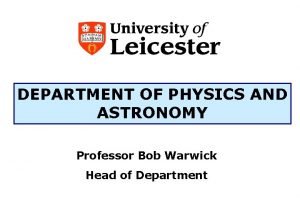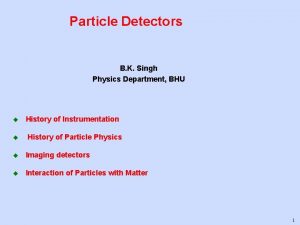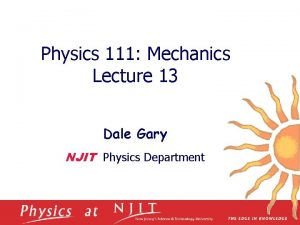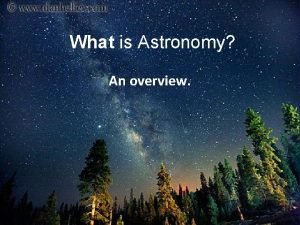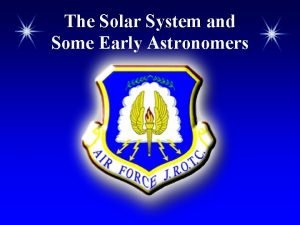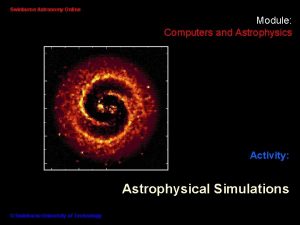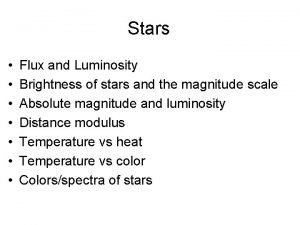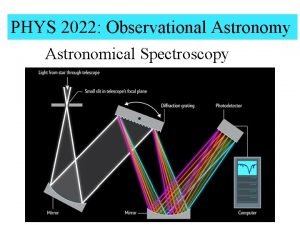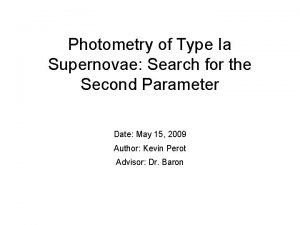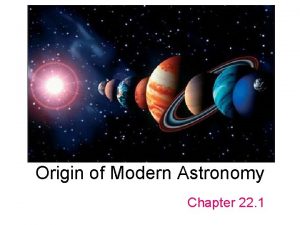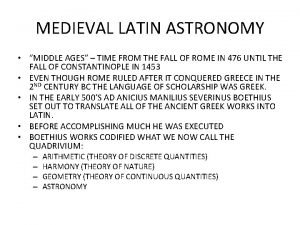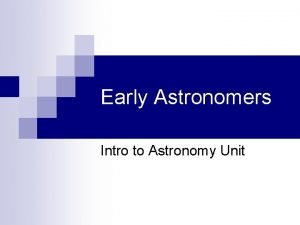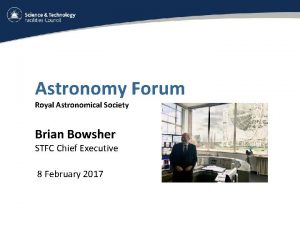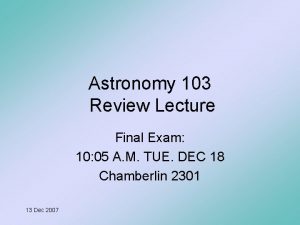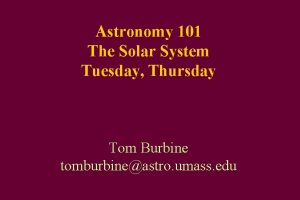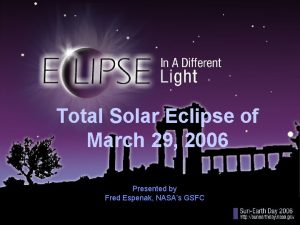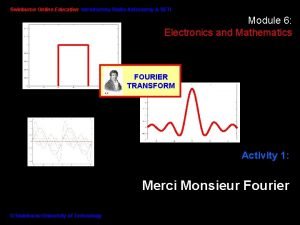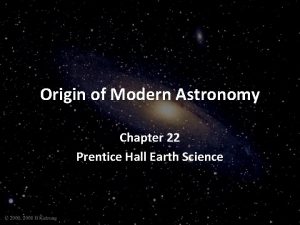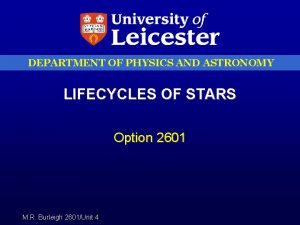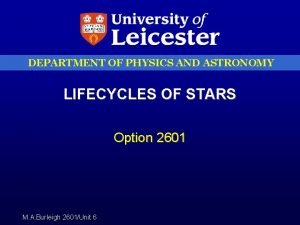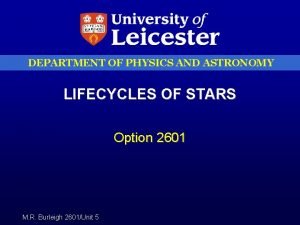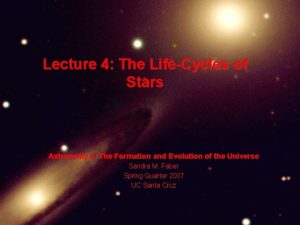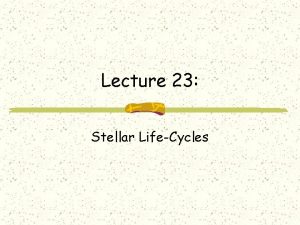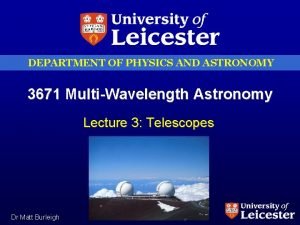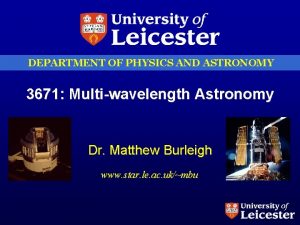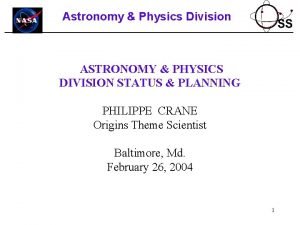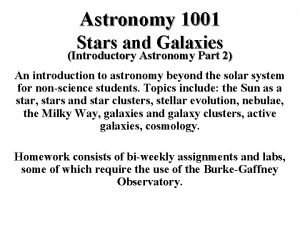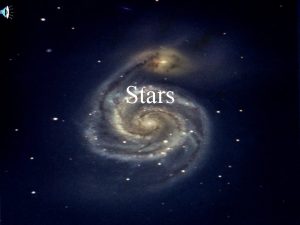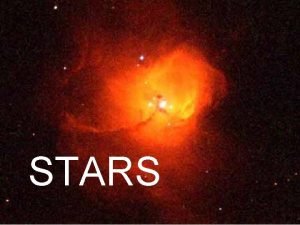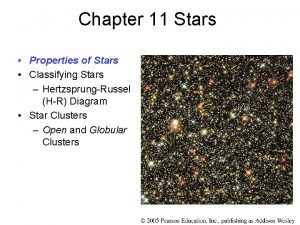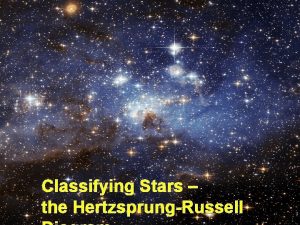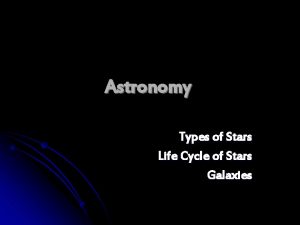DEPARTMENT OF PHYSICS AND ASTRONOMY LIFECYCLES OF STARS








































- Slides: 40

DEPARTMENT OF PHYSICS AND ASTRONOMY LIFECYCLES OF STARS Option 2601 M. R. Burleigh 2601/Unit 1

Books § Introductory Astronomy and Astrophysics – Zeilik and Gregory § Astrophysics I: stars – Bowers and Deeming § The Physics of Stars – A. C. Phillips M. R. Burleigh 2601/Unit 1

Stellar Lifecycle M. R. Burleigh 2601/Unit 1

Starbirth M. R. Burleigh 2601/Unit 1

Young Stars M. R. Burleigh 2601/Unit 1

Globular Clusters M. R. Burleigh 2601/Unit 1

Star Death M. R. Burleigh 2601/Unit 1

Star Death M. R. Burleigh 2601/Unit 1

Star Death M. R. Burleigh 2601/Unit 1

Star Death M. R. Burleigh 2601/Unit 1

Aims and Objectives To introduce you to the underlying physics governing the properties of stars and their evolution M. R. Burleigh 2601/Unit 1

Lifecycles of Stars § Unit 1 - Observational properties of stars § Unit 2 - Stellar Spectra § Unit 3 - The Sun § Unit 4 - Stellar Structure § Unit 5 - Stellar Evolution § Unit 6 - Stars of particular interest M. R. Burleigh 2601/Unit 1

DEPARTMENT OF PHYSICS AND ASTRONOMY Unit 1 Observational Properties of Stars M. R. Burleigh 2601/Unit 1

Observational Properties of Stars § § § The electromagnetic spectrum Radiation Flux, intensity and luminosity Stellar magnitudes and photometry Temperatures masses and radii M. R. Burleigh 2601/Unit 1

The Electromagnetic Spectrum M. R. Burleigh 2601/Unit 1

Atmospheric absorption M. R. Burleigh 2601/Unit 1

The Nature of EM radiation Wave nature: Wavelength Energy M. R. Burleigh 2601/Unit 1 Frequency Planck’s constant

Energy Conversions 1 ke. V = 2. 418 1018 Hz 1 ke. V = 11. 60 106 K 1 ke. V = 1. 24Å 1 ke. V = 1. 6 10 -9 erg 1 J = 107 erg M. R. Burleigh 2601/Unit 1

I Normal Solid angle r A a Spherical surface Total energy flow from the surface of a star Stellar Absolute Luminosity Monochromatic intensity M. R. Burleigh 2601/Unit 1 Stellar distance

Surface flux of star (F): radiant energy Output per unit area of source per second over the whole spectrum: Flux Stellar radius Can also be considered as monochromatic luminosity or flux i. e. L( ), F( ) Brightness (apparent luminosity) is sometimes termed as ‘flux at the Earth’: Inverse square law M. R. Burleigh 2601/Unit 1

Inverse Square Law M. R. Burleigh 2601/Unit 1

Magnitude System § § § Comparison of stars wrt one another Introduced by Hipparchus ~120 BC Catalogued >1000 naked eye stars in order of importance (brightness) § 1 st magnitude = 1 st importance § Extended by Ptolemy 180 AD M. R. Burleigh 2601/Unit 1

Magnitude System § Modern scale dates from 1854, by Pogson § Showed that brightness scale is logarithmic, 1 st mag ~100 x 6 th mag § A step of 1 mag = 10 2/5 = 2. 512 § Can easily calculate differences M. R. Burleigh 2601/Unit 1

Magnitude system Constant Apparent magnitude (m): Absolute magnitude (M): Parallax Distance modulus M. R. Burleigh 2601/Unit 1

Stellar Magnitudes § Any detector (i. e the eye) is only sensitive to a limited wavelength range § Only sampling part of radiation from a star § Photographic film centred on ~420 nm (mpg) § Visual (eye) most sensitive ~550 nm (mv) M. R. Burleigh 2601/Unit 1

Magnitude Definitions Johnson system: U 365 B V R I J H K 440 550 700 900 1250 1. 65 2. 2 nm M. R. Burleigh 2601/Unit 1 L 3. 6 m M N 4. 8 10. 2

Colour Index (B – V) (also U – B etc. ) B-V -ve for 20, 000 K 0 10, 000 K (A 0) e. g. Vega For +ve for M. R. Burleigh 2601/Unit 1 3, 000 K

Bolometric Magnitude Cannot observe mbol directly so use bolometric correction… BC = -0. 07 for the Sun (Teff = 6, 500 K) M. R. Burleigh 2601/Unit 1

Temperature Definitions Wien displacement law: c = 0. 2898 cm deg Stephan-Boltzmann law: Stefan’s constant Planck law: Effective temperature Te Blackbody: h is the Planck constant, k is Boltzmann’s constant M. R. Burleigh 2601/Unit 1

M. R. Burleigh 2601/Unit 1

M. R. Burleigh 2601/Unit 1

Magnitude system Constant Apparent magnitude (m): Absolute magnitude (M): Parallax Distance modulus M. R. Burleigh 2601/Unit 1

Stellar Distances The “Parallax” method of measuring distance… For nearest stars only (<100 pc) M. R. Burleigh 2601/Unit 1

Stellar Distances d a = 1 AU (radians) = a/d = 1 / d (pc) 1 rad = 206, 265 M. R. Burleigh 2601/Unit 1 1 pc = 206, 265 AU

M. R. Burleigh 2601/Unit 1

Distances > 100 pc § Use Sun’s motion through the nearby stars § Motions of relatively nearby star clusters M. R. Burleigh 2601/Unit 1

Measurement of Radii Occultations/eclipses in binary stars Occultations of stars by the Moon Michelson stellar interferometer Interference pattern depends upon angle between wavefronts from opposite limbs of the star Stellar physical diameter Angle in radians M. R. Burleigh 2601/Unit 1 Distance

So What is a Star? § Self-gravitating ball of gas radiating energy § Energy produced by – Thermonuclear reactions – + gravitational/stellar collapse § Star must produce enough energy to maintain internal pressure to counter gravitational field M. R. Burleigh 2601/Unit 1

Physical Principles § Atomic physics radiation processes/spectral lines § Thermodynamics behaviour of gas/stellar structure § Nuclear physics energy generation/creation of heavy elements M. R. Burleigh 2601/Unit 1 Atmospheres Interior

Unit 1 Slides and Notes § Can be found at… – www. star. le. ac. uk/~mbu/lectures. html § In case of problems see me in lectures or email me… mbu@star. le. ac. uk M. R. Burleigh 2601/Unit 1
 Learning astronomy by doing astronomy activity 1 answers
Learning astronomy by doing astronomy activity 1 answers Learning astronomy by doing astronomy
Learning astronomy by doing astronomy Learning astronomy by doing astronomy activity 1 answers
Learning astronomy by doing astronomy activity 1 answers Service fabric performance monitoring
Service fabric performance monitoring There are millions of stars in space
There are millions of stars in space Michigan state university physics
Michigan state university physics Princeton physics department
Princeton physics department Njit physics department
Njit physics department Sputonik v
Sputonik v Warwick physics department
Warwick physics department Bhu physics department
Bhu physics department Iit kanpur physics faculty
Iit kanpur physics faculty Kepler 4 njit
Kepler 4 njit Astronomy questions and answers multiple choice
Astronomy questions and answers multiple choice Modern physics vs classical physics
Modern physics vs classical physics University physics with modern physics fifteenth edition
University physics with modern physics fifteenth edition Physics sl ia ideas
Physics sl ia ideas Branches of astronomy
Branches of astronomy Claudius ptolemy astronomy contributions
Claudius ptolemy astronomy contributions Aristotle astronomy
Aristotle astronomy Swinburne astronomy online
Swinburne astronomy online Mizar luminosity
Mizar luminosity Luminosity and temperature equation
Luminosity and temperature equation Vireo clea
Vireo clea Phys 2022
Phys 2022 Distance ladder astronomy
Distance ladder astronomy Origin of modern astronomy
Origin of modern astronomy Astronomy in medieval times
Astronomy in medieval times Astronomy definition earth science
Astronomy definition earth science Claudius ptolemy astronomy contributions
Claudius ptolemy astronomy contributions Cuhk astronomy
Cuhk astronomy Astronomy vs. astrology
Astronomy vs. astrology Astronomy forum uk
Astronomy forum uk Astronomy 103 final exam
Astronomy 103 final exam Astronomy 101 formulas
Astronomy 101 formulas Astronomy science fair projects
Astronomy science fair projects Astronomy picture of the day march 29 2006
Astronomy picture of the day march 29 2006 Time domain astronomy
Time domain astronomy Ruth bruno
Ruth bruno What is our cosmic address
What is our cosmic address Origin of modern astronomy chapter 22
Origin of modern astronomy chapter 22









